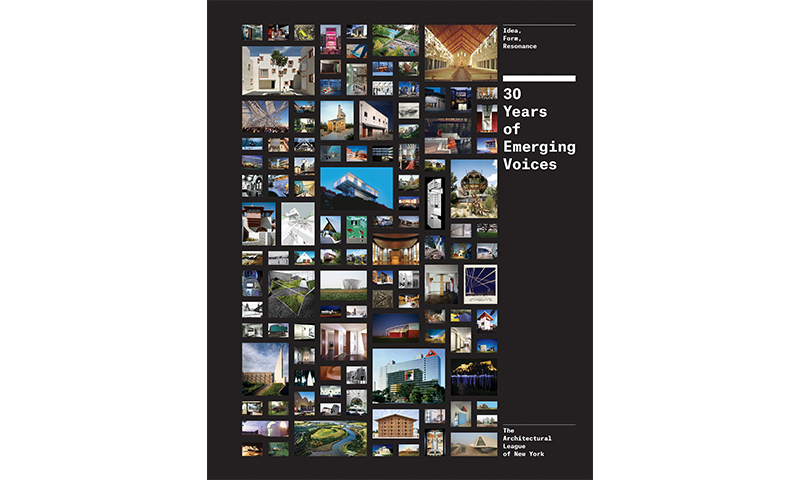by: ac
The Architectural League’s new compilation, 30 Years of Emerging Voices, is a strong cultural artifact for the North American experimental architectural community. I was bemused that each page brought forth a colleague, neighbor, collaborator, teacher, or dear friend. The book serves as a celebration of Anne Rieselbach and Rosalie Genevro’s commitment to the inquiry of architectural practice and the community the Architectural League has nurtured throughout the past 30 years.
Often times, the book has a high school yearbook quality. Like shoulder pads for women, the book affirmed that ziggurat motifs really were a thing of the 1980s, but for every stylistic cringe there is insight into why these practitioners are leaders in their field. I have a renewed veneration for the sublime Halley Studio entrance elevation by Deborah Berke, FAIA, LEED AP, and the hyper-elegant hanrahanMeyers Architects’ Infinity Chapel.
The book is structured in four-year increments, each section introduced by an Emerging Voices juror or a distinguished architectural voice. Alexandra Lange’s essay marking 2013 astutely cites the benchmark conversation that the Denise Scott Brown, FAIA, 2013 Pritzker Prize controversy brought forward, and happily reports that in that year, all the winners were part of this rich tradition of partnerships in architectural practice. An essay by Reed Kroloff, Assoc. AIA, rightly illustrates the epic ”re-ordering” of the architectural conversation due to the advent of the digital age. Additionally, and more interestingly, he credits “the digital” for forcing architectural discourse toward a more builderly end, away from precedent and form. I do wish Kroloff had found a better term – he admits a lack of one – than “rural school” to refer to the ground-breaking work of Coleman Coker and Sam Mockbee, Marlon Blackwell, and Turner Brooks. One of the most exciting things about the culture of the Emerging Voices program is that New York practitioners were placed side by side with practitioners outside of the Ivy League corridor, who often and exuberantly exhibited more formal, social, and cultural invention than their East Coast contemporaries were allowed.
This book is at its best is when it poses questions. Most of it is cross-generational – how would the delightfully innocent framing models of Bausman + Gill’s earlier work match up to the final image in the book, the hyper-varnished Kukji Art Gallery by SO-IL’s Florian Idenburg and Jing Liu? One “hold the page right there” moment is Lars Lerup’s collection of six drawings/analytics, all handmade, all ideas on a page, all culturally profound. At that moment, I yearned for the days of “paper monkeys” and wondered out loud whether ideas made by hand are rewarded in the architectural realm these days.
What I admire about these “winners” is that they moved on, found new partners, pulled back, went to business school, but all moved forward in their careers with the knowledge that an architectural life and the experimental practice of architecture is a vital part of society. 30 Years of Emerging Voices illustrates this and eagerly asks: “What is coming next?”
Event: Oculus Book Talk: 30 Years of Emerging Voices
Location: Center for Architecture, 07.09.15
Speakers: Rosalie Genevro, Executive Director, and Anne Rieselbach, Program Director, The Architectural League of New York; Reed Kroloff, Principal, jones|kroloff;Ashley Schafer, Associate Professor of Architecture, Knowlton School, Ohio State University
Organized by: AIANY Oculus Committee and The Architectural League of New York









